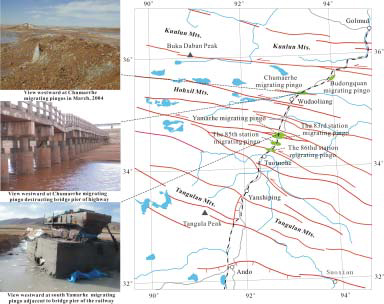Achievements
GEOLOGICAL HAZARDS POSED BY ACTIVE FAULTS AND PERMAFROST TO ENGINEERED FACILITIES
The Golmud-Lhasa Railway crosses the Tibetan Plateau which is characterized by intensely tectonic activity and severe cold climate. About 114 active faults of different sizes and characteristics were identified along the Railway (Wu et al., 2005). Parts of active faults, that slip at higher rates may produce strong earthquakes, and 12 seismic zones are identified along the Golmud-Lhasa Raiwaly (Wu et al., 2004, 2005). Most active faults, especially the minor ones contribute little to the seismic activity, poses hazards of different types to engineered facilities. The coupling among active faulting, underground water flow and feeezing-thawing may result in a variety of geological hazards including seismic fracturing, creep deformation, inhomogeneous freezing and thawing, surface fracture, pingo and migrating pingo (Fig.15). These geological hazards together with earthquakes threaten the safety of railway, highway, oil-pipeline and other engineered facilities such as bridges, culverts and buildings (Wu et al., 2003, 2004, 2005).

Fig. 15 Geological hazards posed by coupling between active faulting and freezing-thawing of permafrost

Fig. 16 Sketch map of active faults and migrating pingos along the Golmud-Lhasa Railway




